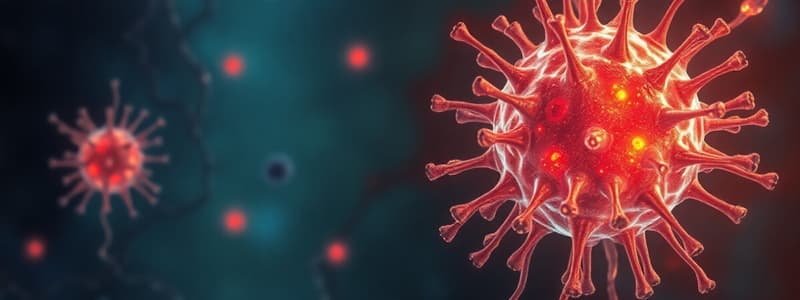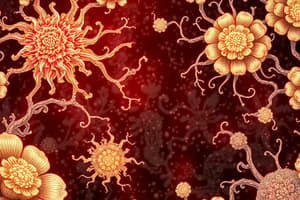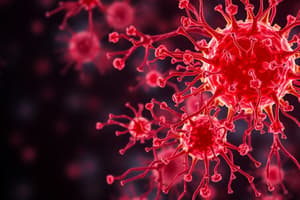Podcast
Questions and Answers
What role do Toll-like receptors (TLRs) play in the immune system?
What role do Toll-like receptors (TLRs) play in the immune system?
- TLRs produce antibodies to fight infection.
- TLRs are responsible for clotting blood.
- TLRs help red blood cells transport oxygen.
- TLRs recognize common structures on different microbes. (correct)
Which cell types are primarily involved in phagocytosis?
Which cell types are primarily involved in phagocytosis?
- Natural killer cells and mast cells
- Eosinophils and basophils
- T cells and B cells
- Neutrophils and macrophages (correct)
How many different Toll-like receptors are found in humans?
How many different Toll-like receptors are found in humans?
- Five
- Seven
- Ten (correct)
- Twelve
What are the stages of phagocytosis?
What are the stages of phagocytosis?
Which scientist identified mammalian TLR4 as the LPS receptor?
Which scientist identified mammalian TLR4 as the LPS receptor?
Which characteristic describes innate immunity?
Which characteristic describes innate immunity?
What is a primary function of complement in innate immunity?
What is a primary function of complement in innate immunity?
Which type of cell is primarily responsible for phagocytosis in the innate immune system?
Which type of cell is primarily responsible for phagocytosis in the innate immune system?
What recognizes pathogen-associated molecular patterns (PAMPs) in innate immunity?
What recognizes pathogen-associated molecular patterns (PAMPs) in innate immunity?
Which of the following components is involved in the internal defenses of innate immunity?
Which of the following components is involved in the internal defenses of innate immunity?
Which statement about natural killer (NK) cells is correct?
Which statement about natural killer (NK) cells is correct?
What is the main role of tight junctions in epithelial cells in innate immunity?
What is the main role of tight junctions in epithelial cells in innate immunity?
Which feature of innate immunity distinguishes it from adaptive immunity?
Which feature of innate immunity distinguishes it from adaptive immunity?
What is the primary function of complement as described in the content?
What is the primary function of complement as described in the content?
Which of the following mediators is NOT involved in inflammation according to the content?
Which of the following mediators is NOT involved in inflammation according to the content?
What is the central component of the complement system?
What is the central component of the complement system?
Which pathway is mainly activated by immune complexes containing IgM or IgG?
Which pathway is mainly activated by immune complexes containing IgM or IgG?
What is a significant consequence of classical pathway deficiencies in complement?
What is a significant consequence of classical pathway deficiencies in complement?
What complex is formed in the classical pathway that leads to the conversion of C3?
What complex is formed in the classical pathway that leads to the conversion of C3?
How does the Membrane Attack Complex (MAC) function within the immune response?
How does the Membrane Attack Complex (MAC) function within the immune response?
Which of the following components is NOT involved in the alternative pathway?
Which of the following components is NOT involved in the alternative pathway?
Which complement component is primarily recognized by CR1 on phagocytes to enhance phagocytosis?
Which complement component is primarily recognized by CR1 on phagocytes to enhance phagocytosis?
How do plasma inhibitors affect the activation of the complement system?
How do plasma inhibitors affect the activation of the complement system?
What is the role of C3b in the complement system?
What is the role of C3b in the complement system?
Which of the following can activate the C1 complex in the classical pathway?
Which of the following can activate the C1 complex in the classical pathway?
What triggers the series of inflammatory events in the complement system?
What triggers the series of inflammatory events in the complement system?
What is the primary function of Natural Killer (NK) cells?
What is the primary function of Natural Killer (NK) cells?
What percentage of blood lymphocytes are comprised of Natural Killer cells?
What percentage of blood lymphocytes are comprised of Natural Killer cells?
How do innate immune cells distinguish 'self' from 'non-self' cells?
How do innate immune cells distinguish 'self' from 'non-self' cells?
What is a characteristic of the innate immune response?
What is a characteristic of the innate immune response?
What role do Toll-like receptors play in the immune system?
What role do Toll-like receptors play in the immune system?
Flashcards
Toll-like Receptors (TLRs)
Toll-like Receptors (TLRs)
A type of pattern recognition receptor (PRR) found on innate immune cells, responsible for recognizing specific molecular patterns on bacteria and other microbes. These receptors trigger an immune response.
Gram-negative bacteria
Gram-negative bacteria
Bacteria with a thin peptidoglycan layer and an outer membrane containing lipopolysaccharide (LPS). They are typically more resistant to antibiotics.
Gram-positive bacteria
Gram-positive bacteria
Bacteria with a thick peptidoglycan layer, lacking an outer membrane. They are typically more susceptible to antibiotics.
Phagocytosis
Phagocytosis
Signup and view all the flashcards
What are the three main steps of phagocytosis?
What are the three main steps of phagocytosis?
Signup and view all the flashcards
Innate Immunity
Innate Immunity
Signup and view all the flashcards
Adaptive Immunity
Adaptive Immunity
Signup and view all the flashcards
Pattern Recognition Receptors (PRRs)
Pattern Recognition Receptors (PRRs)
Signup and view all the flashcards
Pathogen-Associated Molecular Patterns (PAMPs)
Pathogen-Associated Molecular Patterns (PAMPs)
Signup and view all the flashcards
NOD-like receptors (NLRs)
NOD-like receptors (NLRs)
Signup and view all the flashcards
Complement System
Complement System
Signup and view all the flashcards
Natural Killer (NK) Cells
Natural Killer (NK) Cells
Signup and view all the flashcards
Perforin
Perforin
Signup and view all the flashcards
Granzyme
Granzyme
Signup and view all the flashcards
What does the innate immune system do?
What does the innate immune system do?
Signup and view all the flashcards
What is apoptosis?
What is apoptosis?
Signup and view all the flashcards
What is the Membrane Attack Complex (MAC)?
What is the Membrane Attack Complex (MAC)?
Signup and view all the flashcards
What is the role of C5 convertase in the Complement system?
What is the role of C5 convertase in the Complement system?
Signup and view all the flashcards
What are anaphylotoxins?
What are anaphylotoxins?
Signup and view all the flashcards
How does the Complement system contribute to inflammation?
How does the Complement system contribute to inflammation?
Signup and view all the flashcards
How does the Complement system contribute to adaptive immunity?
How does the Complement system contribute to adaptive immunity?
Signup and view all the flashcards
What does complement do?
What does complement do?
Signup and view all the flashcards
What is the central component of the complement system?
What is the central component of the complement system?
Signup and view all the flashcards
What is the Classical Pathway?
What is the Classical Pathway?
Signup and view all the flashcards
What are some activators of the Classical Pathway?
What are some activators of the Classical Pathway?
Signup and view all the flashcards
What are some components of the Classical Pathway?
What are some components of the Classical Pathway?
Signup and view all the flashcards
What does the Classical Pathway generate?
What does the Classical Pathway generate?
Signup and view all the flashcards
What is the Alternative Pathway?
What is the Alternative Pathway?
Signup and view all the flashcards
What is the key function of C3b in the complement system?
What is the key function of C3b in the complement system?
Signup and view all the flashcards
Study Notes
Innate Immunity Lecture Notes
- Learning Objectives:
- Characteristics of the innate immune system
- Pathogen recognition by innate immune cells
- Functions of the innate immune system (phagocytosis, complement, natural killer cells)
Innate Defenses
- Physical Barriers:
- Tight junctions at epithelial cells
- Mucous membranes
- pH
- Antimicrobial secretions (e.g., lysozyme in tears)
- Internal Defenses:
- Phagocytosis
- Complement
- Natural Killer Cells
- Cytokine secretion
Adaptive Defenses
- Humoral Immunity:
- B cells
- Antibodies
- Cell-Mediated Immunity:
- T cells
- Cell killing
- Cytokine secretion
Cells Involved in Innate and Adaptive Immunity
-
Innate Immunity (Hours):
- Basophils
- Eosinophils
- Neutrophils
- Macrophages
- Mast cells
- Natural killer cells
- Dendritic cells
-
Adaptive Immunity (Days):
- Antibodies
- B cells
- Cytokines
- Cytotoxic molecules
- T cells
Features of Innate/Natural Immunity
- Innate immunity is present from birth and is always functional.
- It can respond immediately to pathogens.
- It instructs the adaptive immune system.
- It recognizes non-self (foreign) structures in a non-specific way.
- It has no memory of previous infections and cannot improve its response with experience.
Pathogen Recognition by Innate System Cells
- Proposed by Janeway (1989).
- Innate cells have pattern recognition receptors (PRRs).
- PRRs are encoded in germline cells and have limited diversity.
- Toll-like receptors (TLRs) and NOD-like receptors are examples of PRRs.
- PRRs recognize pathogen-associated molecular patterns (PAMPs)
-shared by different classes of microbes.
- Examples of PAMPs include peptidoglycan, lipopolysaccharide (LPS).
Innate Immune Recognition of Bacterial Cell Wall Components
- Gram-negative bacteria: have lipopolysaccharide in outer membrane, porins.
- Gram-positive bacteria: have teichoic acid and peptidoglycan.
Identical Toll-like Receptors
- Recognize common structures on different microbes.
More on Toll-like Receptors (TLRs)
- Jules Hoffman and others discovered the role of Toll receptors in invertebrates.
- Beutler discovered mammalian TLR4 (responds to LPS).
- Humans have ten different TLRs.
- TLRs are expressed on various cells (e.g., macrophages, dendritic cells).
- TLRs are found on cell surfaces and intracellular vesicles.
Complement
- 30 plasma proteins in an inactive state.
- Become active at infection sites, triggering inflammatory events.
- C3 is a central component in the complement cascade.
- Three pathways activate complement:
- Classical pathway
- Alternative pathway
- Lectin pathway
- A "membrane attack complex" (MAC) forms to lyse pathogens.
Classical Pathway Activation
- Activated by immune complexes containing IgM or IgG.
- Other activators include C-reactive protein, lipopolysaccharide, bacterial porins.
Safety Checks of Classical Pathway
- Covalent binding of C4b and C3b to the activator ensures the reaction stays on the pathogen surface.
- Plasma and host cell inhibitors prevent activation in the absence of a pathogen.
Membrane Attack Complex (MAC)
- Disrupts fluid balance, leading to lysis of pathogens.
- Composed of C5b, C6, C7, C8, and multiple C9 molecules.
Functions of Complement
-
Opsonization:
- C3b binds to complement receptor type I (CR1 or CD35) on phagocytes.
- C5a activates phagocytosis when C3b is bound to CR1.
-
Cell Lysis: Through the membrane attack complex.
-
Inflammation: C3a, C4a, and C5a are inflammatory mediators that activate cells.
-
Recruits adaptive immunity: Some components stimulate B-cell activation.
Deficiencies of Complement
- Deficiency in the classical pathway (especially C1q) increases susceptibility to autoimmune diseases like SLE.
- Can also increase susceptibility to some bacterial infections (e.g., Streptococcus pneumoniae, Haemophilus influenzae).
Natural Killer (NK) Cells
- Lymphoid lineage (10-15% of blood lymphocytes).
- Recognize if a cell has a viral infection or is cancerous.
- Kill infected cells by releasing perforin.
- Perforin creates holes in the target cell membrane.
- Granzyme enters the target cell through the perforin pore
- Induces apoptosis (programmed cell death).
Summary of Main Points
- Innate immunity responds quickly but is non-specific.
- Innate cells do not have memory.
- Innate cells distinguish self from non-self using pattern recognition receptors (PRRs).
- They bind to pathogen-associated molecular patterns (PAMPs).
- Innate functions include phagocytosis, complement activation, NK cell killing.
- Facilitate the killing of pathogens and activate the adaptive immune response.
Studying That Suits You
Use AI to generate personalized quizzes and flashcards to suit your learning preferences.




